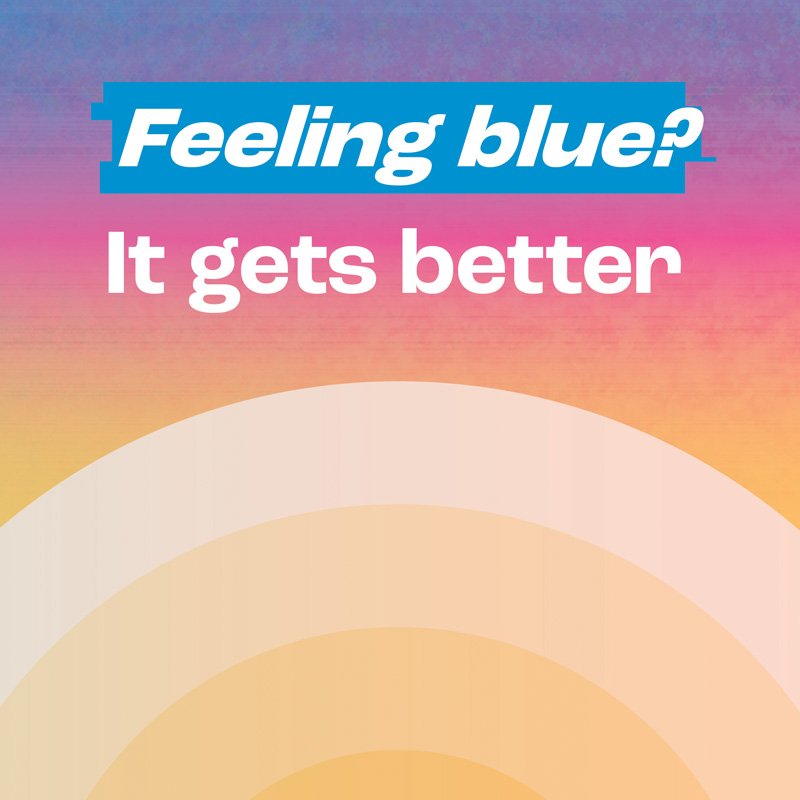- When people experience low mood, they often feel sad, down, gloomy, tired
- or upset
- Low moods are pretty normal – most people feel low now and then
- When low mood sticks around and doesn’t seem to leave us, some people
- call this depression
- Tricky thoughts such as What is the point? or I’m not good enough can pop
- into people’s heads when they are low
- There may be feelings of tiredness, frustration or sadness
- We might also stop doing things we used to enjoy, like hanging out with
- friends or going out of the house
Low mood and LGBTQ+ people
- For Lesbian, Gay, Bisexual, Transgender, Queer/Questioning (LGBTQ+)
- people, experiences of low mood can often be more common
- This is because things around us can affect our mood in an unhelpful way,
- such as things people do or say, things we may read, or the way in which we
- are treated
- We might start to have thoughts such as I wish I wasn’t different or I hate
- myself, which can often reflect what other people have said about us
- If we have a good support network of friends or family, this can sometimes
- help with our mood, but not every LGBTQ+ person has this
Tips to manage anxious feelings
Catch it
Change it
Check it
Contextualise it
Catching low mood
In order to understand how low mood creeps into our life, it is helpful to keep a record.
Think of it like a mood diary, or mood tracker. This helps us to “catch” low mood and understand any patterns.
- Rate your mood out of 10,with 1 being super low, and10 being fab
- What can I feel in my body?
- What thoughts are popping into my head?
- What is happening around me/what am I doing?
- Where am I?
- Is the situation related to
- my LGBTQ+ identity? If so, how?
Checking out low mood
Once we have begun to catch when low mood creeps in, we now need to try check the facts. The best way to do this is to understand how helpful or unhelpful our thoughts are in various situations. This is because we know that thoughts in our head can influence how we feel.
Am I filtering out the good and just focussing on the bad?
Have I become rigid in my thinking? Am I seeing things as ‘this’ or ‘that’, without considering the bits in between?
Am I thinking this might be a bigger deal than it actually is?
Is my thought actually really valid, and letting me know that I should do something to keep myself safe?
Changing low mood
OK, we have caught low mood, and begun to understand when it might show up. We’ve then checked out some of the thoughts we noticed to consider how helpful they are. The next thing to do is try to change some these thoughts, or change what we are doing.
Changing thoughts
Think about the most likely scenario;
Ask other people for feedback on your thoughts;
Imagine your thought ‘on trial’in court – what is the evidence?;
Changing behaviour
Make a list of things you enjoy doing, and schedule these in;
Consider ways to connect to the LGBTQ+ community;
Arrange to call a friend, family member or helpline for support;
Contextualise low mood
One important thing to consider with low mood is context – what is going on? Importantly, is it within my control, and is it affecting my safety? As LGBTQ+ people, we sometimes can’t change big things like laws and policies very easily, though we can consider how we interact with our context, and protect our own bubbles.
I can ask myself: Are there certain people in my life that make me feel sad?
I can ask myself: Is my school/college supportive of my identity? If not, who can I talk to to raise this?
I can ask myself: Are there certain social media pages that make me feel unhappy?
I can ask myself: are there certain laws or rules that mean I can’t do something that others can? If so, who can I contact to express how I feel about this?
